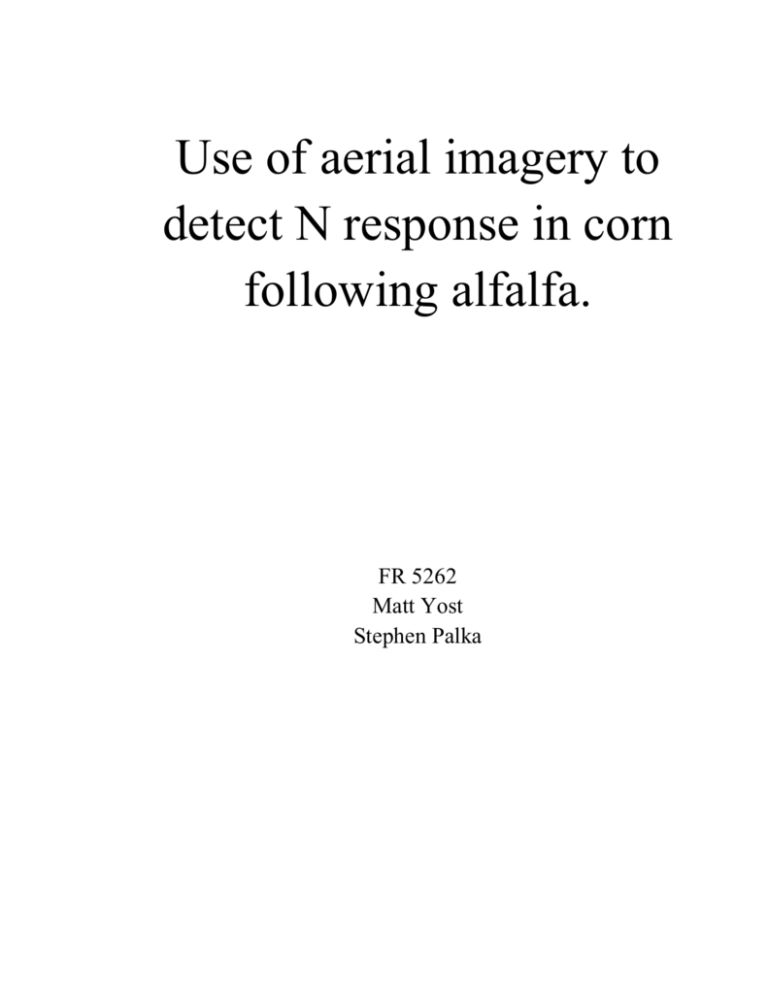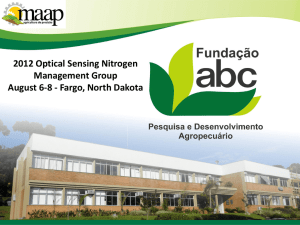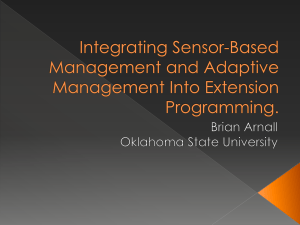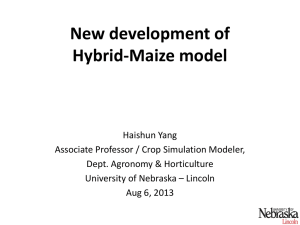Report
advertisement

Use of aerial imagery to detect N response in corn following alfalfa. FR 5262 Matt Yost Stephen Palka Project Description / Objectives: The purpose of this project is to determine whether high spatial resolution aerial imagery can be used to detect differences in corn yield due to nitrogen (N) fertilizer treatments applied to small experimental plots within farmer’s fields. When researchers conduct soil fertility experiments in crop fields such as corn, the yield of crops or plant samples are either measured by handharvesting small areas in each plot (20-40 ft. of corn row), with specialized plot combines, or with large-scale commercial combines. Each of these methods has their advantages and disadvantages. When hand-harvesting corn, the number and size of the samples are often limited because of high labor and time requirements, whereas plot or commercial combines allow for greater samples to be collected, but require large plots and strict calibration of yield monitors and/or weigh wagons. If high spatial resolution aerial imagery could be used to estimate yield [using greenness, normalized difference vegetation index (NDVI), or other indices], then the imagery may be a tool for detecting treatments differences across experimental plots. This would allow researchers to increase the number and size of their experiments and would save much time and labor in the field. Furthermore, farmers and farm advisors could use aerial imagery to estimate yields across their farms and could conduct their own experiments. Methods: In 2010, experiments were established on two Minnesota farms to determine the optimum nitrogen (N) rate for first- and second-year corn following alfalfa. One field is located near St.Rosa, MN and other is near Emmons, MN. At the Rohe farm near St. Rosa, manure was applied to four of the eight main experimental plots in the fall before the corn was planted and 6 N rates were applied to the corn in the spring of 2011. At the Marpe farm near Emmons, MN, there were 16 main plot treatments that were four replications of four treatments (combination of two alfalfa regrowth (none and present) and two tillage timing (fall vs. spring) treatments). All 16 of these plots had 12 N rates applied to the first corn crop in 2010 and again in 2011 (192 small plots). The imagery and this analysis are for 2011 or the second corn crop following alfalfa. At both fields, corn grain and whole plant yield was measured by hand-harvesting 10 ft sections within each of the small plots. At both of these farms, aerial imagery was collected in August of 2011. These images will be used to determine if corn yield differences due to N rate treatments can be detected with NDVI. Data Source Aerial imagery was collected for both of these fields in the fall of 2011 shortly before the corn had reached maturity and began the dry-down (close to the point of maximum growth). The imagery is an RGB composite with one near infrared (NIR) band and spatial resolution of 1m. The imagery was orthorectified by the company that collected the data and was projected in NAD 83 UTM Zone 15N. Process The first step of the process was to import GPS points for each experiment area into ArcGIS. These points were collected with a Trimble GPS unit at very a high degree of accuracy - around 10 cm (points were collected with real-time correction using the Minnesota Department of Transportation - continuous operating reference stations (CORS) network). The TIFF’s of the two experimental areas were then loaded into ArcMap. Polygons were created to break the fields down into the their smaller experiment plots. These plots were based on the GPS points that were previously imported. The fields were broken down in two ways. The first was creating larger plots that represented main plot treatments [(manure application to first-year corn (Rohe farm) and alfalfa regrowth and tillage treatments for second-year corn (Marpe farm)].These polygons were created using the mid-point distance between the plot corners that had GPS coordinates. The smaller polygons that represent the sub-plots in these fields (N fertilizer rates applied to corn) were then created. These polygons were created using the “Direction/Distance” tool in ArcGIS. All of the polygons that were created were then buffered by -0.5 meters in order to be able to create areas of interest that would not have border effects and would try to minimize the number of mixed pixels. The small plots at Rohe were 20 x 20 ft and should have contained about 33 pixels after the 0.5m buffer. The small plots at Marpe were only 15 x 17.5 ft and contained about 21 pixels after the buffer. The feature classes containing each individual small and large plot border for both farms were then exported to shapefiles as they would later be used to to create “Area of interest” layers in ERDAS Imagine. The TIFF images were then opened in ERDAS Imagine. It was observed that the bands were not ordered in the typical way. Band 1 was near infrared, band 2 was red, band 3 was green and band 4 was blue. In order to reorder the bands, the images had to be opened in ArcMap again. Each band of the images were opened and then exported as their own file. An “Image Stack” was then performed in Imagine. The image was stacked in the following order: blue, green, red, NIR. This was done so that we could use ERDAS Imagine’s supervised classification - NDVI, which is based on the bands being ordered as we stacked them. These new images were opened in Imagine and the polygon shapefiles were also added to the viewer. A new area of interest layer was also created for both the large and small plots. The large polygons were then selected and copied to the area of interest layer. These area of interests were again selected. The signature editor was opened and new signatures were added based on the AOI’s. Minimum, maximum, mean, and standard deviation statistics were added to the signature editor. This created a table of values of pixels that resided with the AOI’s only. This process was repeated for each set of polygons. These values were also copied into a Microsoft Excel document so certain band ratios could later be calculated. From this signature editor table, the mean band values for each small and large plot were used to calculate these vegetation indices (IR/Red, NDVI, and TNDVI). The TNDVI was an option in Imagine and is simply a square root transformation of NDVI in the case that the values are non-normal. We also tried two other methods of calculating NDVI in Imagine. A supervised classification of NDVI was performed for the whole image at Marpe and for only the area of interest at Rohe. We were interesting in comparing whether the mean values for these plots would be different this way. We found that the difference between using the signature editor and supervised classification was minimal if the whole image was classified with supervised classification at Marpe (r2= 0.99). However, at Rohe where we used supervised classification for only the area of interest, the correlation between the two NDVI values was not as good (r2=0.91). This indicates that area of interest supervised classification is not as accurate. We decided to use the mean NDVI values we calculated for the remainder of the analysis. Results: The average NDVI values calculated manually with the signature editor were lined up with the corn grain yield from both farms and the corn silage or whole plant yield from Rohe. The average NDVI values at the Marpe farm were lower than the NDVI values from Rohe. The correlation between corn grain yield and NDVI, IR/Red, and TNDVI was poor at the Marpe farm; the highest r2 value was only 0.005. However, the correlations at the Rohe farm were actually quite good (r2 values between 0.42-0.45) for grain yield. Silage yield at Rohe had the higher correlation to the indices that grain yield (r2 values between 0.48 and 0.53). The difference in correlations between yield and vegetation indices was small at both farms, but the IR/Red index typically had the highest correlation. We are not certain why the correlations of yield and vegetation indices at Marpe were much lower than Rohe. It may be due to more mixed pixels at Marpe because of the smaller plot size (22 pixels compared to 33 pixels at Rohe), but other field characteristics may have affected the values. Although the IR/Red index was slightly more correlated to yield than NDVI, the difference between this and NDVI was likely not significant and so we decided to first use NDVI to try and detect corn yield differences due to fertilizer N treatments. To test whether NDVI could detect treatment differences across the plot areas we used yield and NDVI as independent variables in an analysis of variance. The experiment was designed as a randomized complete block design and was analyzed separately by farm with main (manure, alfalfa regrowth, and tillage timing) and sub-plot treatments (fertilizer N rates) as fixed effects and blocks within location as random. The significance (P < 0.05) of the main and sub-plot treatments were the same for yield and NDVI at both farms (Table 1); both analyses showed that fertilizer N rate was the only treatment that had a significant effect on corn yield or NDVI. These results are very encouraging because they signify that the aerial image alone could detect yield differences due to N treatments. Table 1. Analysis of variance results for the fixed effect of manure, regrowth, and fertilizer N on corn yield and normalized difference vegetation index (NDVI). Farm Main effect Grain yield Silage yield NDVI -------------- P > F -------------Rohe Manure 0.484 0.164 0.326 N 0.003 0.025 0.042 Manure*N 0.515 0.339 0.952 Marpe Regrowth N Regrowth*N 0.177 0.021 0.234 - 0.656 0.018 0.835 The next step forward in using NDVI to detect treatment differences in small plot experiments, is to determine whether NDVI can be used to predict the level of response to a treatment. Therefore, the regression models for yield and NDVI were evaluated for both farms and are shown in figures on the next page. The slope of NDVI and grain yield could not be compared for Rohe because the grain yield fit a quadratic regression model and NDVI was linear. The slope of silage yield response to fertilizer N, could significantly fit a linear model, so there may be potential to relate the silage or whole plant yield to NDVI. The grain yield response to fertilizer N at Marpe fit nicely to a linear regression model, but NDVI had poor correlation with fertilizer N rate (r2=0.26). This may be small plot size, more mixed pixels, or other characteristics about the corn or growing conditions. Rohe – grain (left), silage (right), and NDVI (bottom) response to fertilizer N. Marpe – grain (left) and NDVI (right) response to fertilizer N. Conclusions: The results of this study show that NDVI can be used to detect differences in corn grain and silage yield due to fertilizer N rates applied near corn planting. Therefore, aerial imagery could be a potential tool for researchers and farmers to use in adjusting N rates applied to corn. This tool may especially be useful for corn after alfalfa because the corn often requires no fertilizer N to maximize corn grain yield. A few N rates could be applied to many fields across the state and then aerial imagery could be used to detect when there was an N response to fertilizer. This would allow for many field trials to be conducted at a very low cost. If the relationship between N response in corn and response in NDVI could be validated across more fields, an online tool could be developed to help farmers turn in GPS points of their plot corners and details of their treatments, and then NDVI differences could be analyzed across plots. This would be especially useful for farmers that don’t have expensive yield monitors on their combines. What We Would Have Changed If we were to redo this project there are many factors that we would change. The imagery we used only had four bands available. We had originally wanted to use a greenness index using a tassel cap classification to see if this would have given us a better representation of the health and yield of a certain plot. However, we did find that in order to calculate this index you needed 7 bands and seems to be specific to the Landsat TM sensor or IKONOS. It would also have been better to have larger experiment areas. The areas that we had to use for AOI’s were very small, containing only 20 - 30 pixels. Larger field plots would have also enabled us to use a sensor with a coarser spatial resolution. This would have given us access to more information. This would have created the possibility of letting us look at the different index values at varying times throughout the growing season to see if that would have given us better results.





